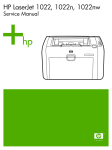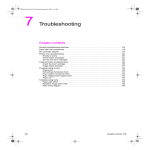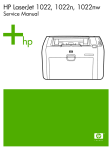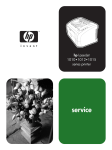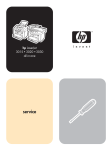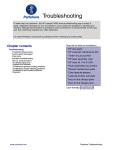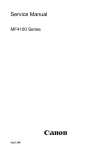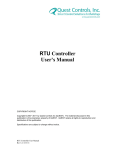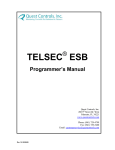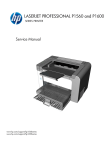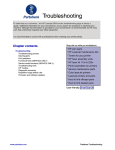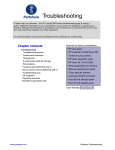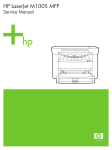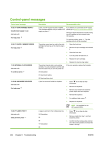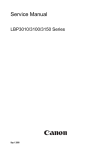Download HP LaserJet 1010/1012/1015/1020 Service Manual
Transcript
Troubleshooting To better help our customers - this HP Laserjet 1010 1015 1020 series troubleshooting page is simply a guide / additional information for your convenience, as you search for assistance in repairing your machine. Although this information is provided for your convenience it is recommended, for the most part, that a technician inspects your office equipment. It is recommended to consult with a professional when ordering your printer part(s). Chapter contents Troubleshooting Basic troubleshooting Control-panel power-on functions (HPLaserJet 1010 series printers) Control-panel pages (HP LaserJet 1010 series printers only) Control-panel lights (HP LaserJet 1010 series printers) Control-panel lights (HP LaserJet 1020 printer) Jams Print-quality troubleshooting Solving paper-feed problems Functional checks Troubleshooting tools Solenoid, sensors, switches, and motor Shop with us while you troubleshoot. * HP oem parts * HP LaserJet maintenance kits .........printer * Toners for your * HP fuser assembly units * HP fuser kit 110v & 220v * Parts assemblies for printers * Service maintenance parts .................................... * Color laserJet printers * LaserJet printers and parts * Hard to find officejet parts * Hard to find deskjet parts User-friendly SmartSearch! www.partshere.com Partshere Troubleshooting Troubleshooting This chapter describes how to isolate and resolve printer problems, print-quality problems, and media problems. Troubleshooting details are provided to resolve problems or to isolate replaceable parts. Ɣ Basic troubleshooting Ɣ Control-panel power-on functions (HP LaserJet 1010 series printers) Ɣ Control-panel pages (HP LaserJet 1010 series printers only) Ɣ Control-panel lights (HP LaserJet 1010 series printers) Ɣ Control-panel lights (HP LaserJet 1020 printer) Ɣ Jams Ɣ Print-quality troubleshooting Ɣ Solving paper-feed problems Ɣ Functional checks Ɣ Troubleshooting tools Ɣ Solenoid, sensors, switches, and motor www.partshere.com Partshere Troubleshooting Basic troubleshooting Troubleshooting checklist Table 6-1 Basic troubleshooting Did the printer turn on? Cause Solution No power is available because the power source, cable, or switch failed. 1 Verify that the product is plugged in. Make sure that the printer is plugged directly into a working wall receptacle. 2 Verify that the power cable is functional and that the power switch is on. 3 If these conditions are correct, replace the engine power assembly. 1 Make sure that the printer is plugged directly into a working wall receptacle. 2 Verify that the print-cartridge door is closed. 3 Verify that the print path is clear. If it is, verify that the printpath paper-sensor arms are clean and functional. 4 Verify that the cable from the ECU to the motor is connected. 5 If these conditions are correct, replace the ECU. See Engine control unit (ECU) assembly on page 92. 6 If, after replacing the ECU, the printer motor still does not rotate, replace the engine-power assembly. See Enginepower assembly on page 87. 7 If, after replacing the ECU and engine-power assembly, the printer motor still does not rotate, replace the printer. The printer motor does not rotate. The motor rotates, but the lights are not on. Is the product ready? Cause Solution The formatter is damaged or has a loose connection. Verify that the formatter cables are connected correctly. If all cables are undamaged and seated correctly but the problem persists, replace the printer. Print a demo page by pressing the GO button (HP LJ 1010 series only) when the printer is idle. Does the demo page print? Cause www.partshere.com Solution Partshere Troubleshooting Table 6-1 Basic troubleshooting (continued) Print a demo page by pressing the GO button (HP LJ 1010 series only) when the printer is idle. Does the demo page print? Cause Solution The media does not move smoothly through the paper path. If the media is consistently jamming and the paper path is clear, replace either the paper-pickup assembly or the fuser, depending on where it is jamming. Poor print quality is evident. See Print-quality troubleshooting on page 111. Is the software installed correctly? Cause Solution The software is not installed correctly, or an error occurred during software installation. Uninstall and then reinstall the product software. Make sure that you use the correct installation procedure and the correct port setting. Connect the USB cable (or the parallel cable, on the HP LaserJet 1015) to the printer and the computer. Print a test page from the Printer Properties dialog box or print from a software program like Notepad. Does the product print from the computer? Cause Solution The cable is not connected correctly. Reconnect the cable. An incorrect driver is selected. Select the correct driver. Other devices are connected to the parallel port. Disconnect the other devices and try again to print. An LPT port driver problem exists in Microsoft® Windows®. Correct or reset the computer port settings. www.partshere.com Partshere Troubleshooting Control-panel power-on functions (HP LaserJet 1010 series printers) Turning on the printer while pressing the GO button for varying amounts of time provides important printer functionality for resetting the printer, resetting NVRAM, and performing self-tests. Use the following procedure to initiate a power-on function, see on page 100 for the specific time ranges for the poweron functions. 1 Turn off the printer. 2 Press and hold the GO button. 3 Turn the printer on again while holding the GO button for the amount of time specified in Table 6-2 Power-on functions: time ranges (HP LJ 1010 series printers only) on page 100 for the function that you want to complete. 4 Release the GO button. NOTE Make sure that the lights indicate the function when you release the GO button. If the light status indicates the wrong function when you release the GO button, restart the power-on procedure. Table 6-2 Power-on functions: time ranges (HP LJ 1010 series printers only) Power-on function Time range (seconds) Light status Results and notes Cold reset Release GO 10 to 20 seconds after power-up. ATTENTION: on The lights begin cycling from front to back. The cold-reset process runs until completion, and then the printer enters the Ready state. READY: off GO: off Continuous self-test Release GO 20 to 30 seconds after power-up. ATTENTION: on READY: on GO: off NVRAM initialization Release GO 30 to 40 seconds after power-up. ATTENTION: on READY: on GO: on Error report Release GO 40 to 50 seconds after power-up. ATTENTION: off READY: on The Ready light blinks, indicating that the device is in the continuous self-test mode. To terminate the continuous self-test, press the GO button. The lights begin cycling from front to back. The NVMEM initialization process runs until completion, and then the printer enters the Ready state. The printer produces an error report that shows the most recent error. GO: on www.partshere.com Partshere Troubleshooting Control-panel pages (HP LaserJet 1010 series printers only) When the printer is in the Ready state, pressing the GO button for varying amounts of time produces important printer reports. Use the following procedure to initiate the reports, and see Table 6-3 Controlpanel pages: time ranges (HP LJ 1010 series printers only) on page 101 for the specific time ranges for each report. 1 Ensure that only the READY light is on. 2 Press and hold the GO button. 3 Release the GO button after the amount of time shown in Table 6-3 Control-panel pages: time ranges (HP LJ 1010 series printers only) on page 101 for the report you want. Table 6-3 Control-panel pages: time ranges (HP LJ 1010 series printers only) Control-panel page Time range (seconds) Light status Results and notes Demo Page Release GO after 0 to 4 seconds. ATTENTION: off A demo page prints. READY: blinking GO: off Configuration Report Release GO after 5 to 9 seconds. ATTENTION: off A configuration report prints. READY: off GO: on Cleaning Page Release GO after 10 seconds. ATTENTION: on READY: on GO: on www.partshere.com The printer completes a cleaning cycle by using the media that is loaded in the printer. Use a transparency for the best results. Partshere Troubleshooting Control-panel lights (HP LaserJet 1010 series printers) The printer indicates status and errors through patterns of the GO, READY, and ATTENTION lights. If any lights are blinking, the error can usually be resolved. 1 If the error pattern occurs when printing, try pressing the GO button to continue. 2 Make sure that the print cartridge is installed correctly and the print-cartridge door is closed. 3 Turn the printer power off and then on again. Control-panel light patterns (HP LJ 1010 series printers) The lights on the printer, from back to front, are the GO, READY, and ATTENTION lights. Each light can be on solid or blinking. When the three blink in sequence, the activity is called “cycling.” In this document, the light status is represented as follows: On Blinking Off Cycling Figure 6-1 Control-panel-lights legend Table 6-4 Control-panel light patterns (HP LJ 1010 series printers) Printer status Initialization/startup Lights Go Ready Description During Initialization/startup, the lights cycle one after another in a front-to-back pattern (the "landing lights" pattern). Pressing buttons has no effect when this is the printer status. Attention Reconfig initialization Go Ready When a power-on function is activated (for example, during a cold reset or NVRAM initialization) the lights cycle as in the startup state. Pressing buttons has no effect when this is the printer status. Attention Ready (The printer is ready, with no job activity.) Go Ready In the Ready state, the READY light is on and the GO and ATTENTION lights are off. In this state, the printer has no errors and is ready to receive data. Pressing the GO button prints a demo page. Attention www.partshere.com Partshere Troubleshooting Table 6-4 Control-panel light patterns (HP LJ 1010 series printers) (continued) Printer status Processing data (The printer is processing or receiving data.) Lights Go Ready Attention Job cancellation Go Ready Description During data processing, the READY light is blinking and the GO and ATTENTION lights are off. Pressing the GO button cancels the current job without printing another page. The printer returns to the Ready state after the job has been canceled. During job-cancellation, all of the lights cycle. Pressing the GO button has no effect. After the job-cancel process is complete, the printer returns to the Ready state. Attention Continuable error Go Ready Attention When a continuable error exists, the GO light is on, the READY light is off, and the ATTENTION light is blinking. Press the GO button to attempt to recover from the error and continue printing. If the printer recovers from the error, it will start to process data and will complete the job. If the recovery fails, the device will return to the continuable-error state. The following actions and events cause continuable errors: www.partshere.com Ŷ Manual feeding Ŷ Out of paper for the specified tray Ŷ General continuable error Ŷ Memory overflow (error 20) or memory full (PCL only) Ŷ Temporary engine error (41.x errors) Ŷ I/O error (22 error) / buffer flow error (only with parallel connections) Ŷ I/O data error (40 error) (bad connection) (only with parallel connections) Ŷ Memory configuration error Ŷ Personality/job-related error Ŷ Fuser high temperature (50.011 error) Partshere Troubleshooting Table 6-4 Control-panel light patterns (HP LJ 1010 series printers) (continued) Printer status Lights Description NOTE The LJ 1010 series printers do not have paper-out sensors. When the printer enters a continuable error state because it is out of paper, the user needs to reload paper and press the GO button to continue. The lights provide no secondary error information. Attention state Go Ready Attention In the Attention state, the ATTENTION light is blinking and the GO and READY lights are off. The following conditions create the attention state: Ŷ A tray is empty. Ŷ A door is open. Ŷ The print cartridge is missing. Ŷ A jam exists, or a tray has misfeed. Press the GO button to attempt to reset the printer after a jam is cleared. Pressing the GO button has no effect in the other error cases. You might need to clear the error manually and then press the GO button or close the top cover. If the error persists, the printer will return to the attention state. NOTE The LJ 1010 series printers does not have paperout sensors. When the printer is in an Attention state because the input tray is empty, the user must reload media and then press the GO button. Fatal error Go Ready All three LEDs are on continuously in the fatal-error state. Press the GO button to see the secondary error information for the fatal error. When you release the button the printer returns to the initial Fatal-error state. Attention www.partshere.com Partshere Troubleshooting Table 6-4 Control-panel light patterns (HP LJ 1010 series printers) (continued) Printer status Cleaning page Lights Go Ready Description Use the HP Toolbox to initiate the cleaning function. Pressing the GO button has no effect during the cleaning mode. Attention Sleep mode Go From the customer's perspective, sleep mode is the same as Ready mode. Ready Attention Fatal errors (HP LJ 1010 series printers) If all of the printer lights are on (solid) and you cannot resolve the error by turning the printer off and on, then a fatal error has occurred. Two errors scan be identified: failed communication between the formatter and the engine, and a failed fuser. If neither of these is identified by using the following procedure, replace the printer. 1 Press and hold the GO button. The printer shows a secondary error pattern. 2 If the ATTENTION light illuminates as the secondary error pattern, the formatter and engine are not communicating. 3 Ɣ Check the ribbon cable between the formatter and ECU, and check all other connections. Ɣ If the error persists, replace the ECU. Ɣ If the error persists, replace the printer. If the GO and READY lights illuminate as the secondary error pattern, the fuser (fixing assembly) has failed and must be replaced. www.partshere.com Partshere Troubleshooting Control-panel lights (HP LaserJet 1020 printer) The ATTENTION and READY lights indicate printer status and errors. Figure 6-2 Control-panel lights (HP LJ 1020 printer) Status-light patterns Off On Blinking Figure 6-3 Control-panel-light legend (HP LJ 1020 printer) Table 6-5 Control-panel light patterns (HP LJ 1020 printer) Light status State of the printer Action Ready No action is necessary. The product is ready to print. Processing data Wait for the job to print. The product is receiving of processing data. Cleaning mode A cleaning page is printing. www.partshere.com Wait until the cleaning page has finished and the printer is in the Ready state. This could take up to two minutes. Partshere Troubleshooting Table 6-5 Control-panel light patterns (HP LJ 1020 printer) (continued) Light status State of the printer Action Out of memory The page you are printing might be too complex for the printer's memory capacity. Try lowering the resolution. The printer is out of memory. Attention: door open, no print cartridge, or media jam Check the following: Ŷ The print cartridge door must be completely closed. Ŷ The print cartridge is correctly installed. Ŷ There is no media jam. The printer is in an error state that requires operator intervention. Printer initialization No action is necessary. The printer is initializing. Fatal error Turn off the printer, and then unplug the printer power cord for 30 minutes. Plug the printer power cord into the power outlet, and then turn the printer on. If the error persists, replace the printer. See Printer exchange/parts on page 139. Both lights are off. Make sure that the power switch is in the on position. Make sure that the printer power cord is plugged into a active power outlet. Unplug both ends of the printer power cord, and then plug the power cord back into the printer and the power outlet. www.partshere.com Partshere Troubleshooting Jams Clearing jams CAUTION Do not use sharp objects, such as tweezers or needle nose pliers, to remove jams. Damage caused by sharp objects will not be covered by the warranty. CAUTION Always pull jammed media in the direction it would travel through the paper path. Do not pull jammed media against the direction of travel through the paper path to avoid damage to the printer. To prevent damage to the printer when clearing jams, including jams in the output bin, always open the print-cartridge door and remove the print cartridge. Keep the door open and the cartridge out until the jam has been cleared. Opening the print-cartridge door and removing the print cartridge relieves tension on the printer rollers, which prevents damage to the printer and makes the removal of jammed pages easier. Occasionally, media becomes jammed during a print job. You are notified of a media jam by an error from the software and the printer control panel lights. See Control-panel lights (HP LaserJet 1010 series printers) on page 102 or Control-panel lights (HP LaserJet 1020 printer) on page 106. The following are some of the causes of media jams: Ŷ The input trays are loaded improperly or are too full. See Loading media on page 25. NOTE When you add new media, always remove all of the media from the input tray and straighten the stack of new media. This helps prevent multiple sheets of media from feeding through the printer at one time, reducing media jams. Ŷ The media does not meet HP specifications. See Media specifications on page 21. Typical media jam locations Ŷ Print cartridge area: See Removing a jammed page on page 43. Ŷ Input tray area: If the page is still sticking out of the input tray, gently try to remove it from the input tray without tearing the page. If you feel resistance, see Removing a jammed page on page 43. Ŷ Output path: If the page is sticking out of the output bin, see Removing a jammed page on page 43. NOTE There might be loose toner in the printer after a media jam. This toner clears up after a few sheets are printed. Removing a jammed page Use the procedures in this section to remove a jam. CAUTION Media jams might result in loose toner on the page. If you get any toner on your clothes, wash them in cold water. Hot water will permanently set the toner into the fabric. www.partshere.com Partshere Troubleshooting CAUTION To prevent damage to the printer when clearing jams, including jams in the output bin, always open the print cartridge door and remove the print cartridge. To prevent damage to the print cartridge, minimize its exposure to direct light. Cover the print cartridge with a sheet of paper. NOTE The following illustrations show the HP LaserJet 1020 printer. The same procedure is used to remove a jam in the HP LaserJet 1010 series printers. 1 Open the print cartridge door, and remove the print cartridge. 2 Grasp the middle edge of the side of the media that is most visible, and carefully pull it free from the printer. CAUTION Do not use sharp objects, such as tweezers or needle nose pliers, to remove jams. Damage caused by sharp objects will not be covered by the warranty. CAUTION Always pull jammed media in the direction it would travel through the paper path. Do not forcefully pull jammed media against the direction of travel through the paper path to avoid damage to the printer. www.partshere.com Partshere Troubleshooting 3 When you have removed the jammed media, replace the print cartridge, and close the print cartridge door. After clearing a media jam, you might need to turn the printer off then on again. NOTE When you add new media, remove all of the media from the input tray and straighten the stack of new media. www.partshere.com Partshere Troubleshooting Print-quality troubleshooting Print-cartridge problems Checking the print cartridge Image-formation defects are frequently the result of problems in the print cartridge. If there is any doubt, always replace the print cartridge before troubleshooting image defects. Hint If the transfer roller was recently replaced, print-quality problems might be the result of skin oils on the black-sponge portion of the transfer roller. Do not touch the black-sponge portion of the transfer roller when replacing it. Use the following checklist to make sure that the print cartridge is still operable. Ŷ Make sure that the print cartridge is installed properly and the shipping tape is removed. Ŷ Check the print cartridge to see if it has been disassembled or refilled. Ŷ Inspect the print cartridge to see if toner is leaking through worn seals. Ŷ Check the surface of the photosensitive drum in the cartridge to see if it has been damaged or scratched. Touching the drum contaminates the photosensitive surface and can cause spotting and image defects. Ŷ Blurred areas on printed pages indicate that the photosensitive drum in the cartridge has been overexposed to light. Because overexposure to light causes permanent damage to the photosensitive drum, the cartridge should be replaced. To redistribute toner in the print cartridge Before installing a new print cartridge or when toner begins to run low, redistribute the toner by rocking the cartridge back and forth five or six times. Solving print-quality problems Use the following tables to help solve problems with printed pages. If the problem occurs when printing, see Solving paper-feed problems on page 122. Table 6-6 Solving print-quality problems No page is produced. Cause Solution The product is not plugged in or power switch is off. Make sure that the product is plugged into a live wall outlet or power strip and that the on/off switch is in the on position. The printer is registering a jam. Check the lights. If the ATTENTION light is flashing, the printer might be jammed. Clear the jam. For the HP LJ 1010 series, press the GO button to clear the jam. The computer cable is loose. Make sure that the cable between the product and the computer is securely connected. www.partshere.com Partshere Troubleshooting Table 6-6 Solving print-quality problems (continued) Output pages are blank. Cause Solution The tape was not removed from the print cartridge. Remove the print cartridge, remove the tape, and reinstall the print cartridge. The print cartridge is out of toner. Replace the print cartridge The high-voltage connection between the printer and the print cartridge has been interrupted. Perform a High-voltage-contacts check on page 127. The laser/scanner shutter lever is not installed correctly or is broken. If the ECU was recently replaced, make sure that the laser/ scanner shutter lever was inserted correctly through the plastic guide in the sheet-metal ECU cover when the cover was reinstalled. See Engine control unit (ECU) assembly on page 92. If the laser/scanner shutter is broken, replace the printer. See Printer exchange/parts on page 139. Parts of the page around the edges are not printing. Cause Solution The printer cannot print all the way to the edge of the paper. The printer has minimum margins on each edge of approximately 6 mm (0.25 inch). To make the image fit into this printable area, slightly reduce the size of the image. Open the Printer Properties dialog box, and then select Printing Preferences. Select the Effects tab and then click on the Print Document On check box in the Fit to Page area of the dialog box. if the a page size other than Letter is used, select the appropriate page size from the drop down menu. Click OK to close the Printing Preferences dialog box, and then click OK again to close the Printer properties dialog box. The reduction setting is incorrect. To make changes to the reduction settings, open the Printer Properties dialog box, and then select Printing Preferences. Select the Effects tab and then change the reduction settings in the Fit to Page area of the dialog box. Click OK to close the Printing Preferences dialog box, and then click OK again to close the Printer properties dialog box. The paper-size setting is incorrect. To make a change to the paper-size settings, open the Printer Properties dialog box, and then select Printing Preferences. Select the correct paper-size setting from the Size is drop down menu. Click OK to close the Printing Preferences dialog box, and then click OK again to close the Printer properties dialog box. www.partshere.com Partshere Troubleshooting Table 6-6 Solving print-quality problems (continued) Random toner specks appear on the printed page. Cause Solution The media in use does not meet HP specifications (for example, it is too moist or too rough). Make sure that the media meets specifications detailed in the HP LaserJet Printer Family Print Media Guide. The print path is dirty. Clean the print path (see Cleaning the print path on page 31). Characters are only partially printed (also referred to as dropouts). Cause Solution A single sheet of paper is defective. Try reprinting the job. The print density needs to be adjusted. HP LJ 1010: Adjust the print density from the HP Toolbox (on the Settings tab) or open the Printer Properties dialog box, and then select the Configure tab. Use the slide bar in the Print Density area of the dialog box to change the print density setting. Click OK to close the Printer Properties dialog box. HP LJ 1020: Open the Printer Properties dialog box, and then select the Configure tab. Use the slide bar in the Print Density area of the dialog box to change the print density setting. Click OK to close the Printer Properties dialog box. The moisture content of the paper is inconsistent, or the paper has moist or wet spots on the surface. Make sure that the media meets the specifications detailed in the HP LaserJet Printer Family Print Media Guide. The paper was damaged by inconsistent manufacturing processes. Make sure that the media meets the specifications detailed in the HP LaserJet Printer Family Print Media Guide. Economode is enabled. Open the Printer Properties dialog box, and then select Printing Preferences. Select the Finishing tab, and then clear the EconoMode (Save Toner) check box. Click OK to close the Printing Preferences dialog box, and then click OK again to close the Printer properties dialog box. The wrong type of media is selected in the Printer Preferences dialog box. Open the Printer Properties dialog box, and then click Printing Preferences. Select the correct media type from the Type Is drop down menu. Click OK to close the Printing www.partshere.com Partshere Troubleshooting Table 6-6 Solving print-quality problems (continued) Characters are only partially printed (also referred to as dropouts). Cause Solution Preferences dialog box, and then click OK again to close the Printer properties dialog box. The print cartridge is depleted or damaged. Replace the print cartridge. Rarely, the fuser might be damaged. Replace the fuser. Vertical black lines appear on the printed page. Cause Solution The print cartridge is depleted or damaged. Replace the print cartridge. Rarely, the fuser is defective. Replace the fuser. The printed page has a gray background. Cause Solution The wrong type of media is selected in the Printer Preferences dialog box. Open the Printer Properties dialog box, and then click Printing Preferences. Select the correct media type from the Type Is drop down menu. Click OK to close the Printing www.partshere.com Partshere Troubleshooting Table 6-6 Solving print-quality problems (continued) The printed page has a gray background. Cause Solution Preferences dialog box, and then click OK again to close the Printer properties dialog box. The print density is too high. HP LJ 1010: Adjust the print density from the HP Toolbox (on the Settings tab) or open the Printer Properties dialog box, and then select the Configure tab. Use the slide bar in the Print Density area of the dialog box to change the print density setting. Click OK to close the Printer Properties dialog box. HP LJ 1020: Open the Printer Properties dialog box, and then select the Configure tab. Use the slide bar in the Print Density area of the dialog box to change the print density setting. Click OK to close the Printer Properties dialog box. The media basis weight is too high. Change the media to a lower basis weight. The print path needs to be cleaned. Clean the print path (see Cleaning the print path on page 31). The printer is operating in humidity or temperature conditions that are not within the recommended ranges. Move the product to a different location. The print cartridge is worn, damaged, or has been refilled. Replace the print cartridge. Toner smears appear on the printed page. Cause Solution If toner smears appear on the leading edge of the media, the media guides might be dirty. Wipe the media guides with a dry, lint free cloth. The print path needs to be cleaned. Clean the print path (see Cleaning the print path on page 31). The media in use does not meet HP specifications (for example, it is too moist or too rough). Make sure that the media meets the specifications detailed in the HP LaserJet Printer Family Print Media Guide. The print cartridge is worn or damaged. Replace the print cartridge. www.partshere.com Partshere Troubleshooting Table 6-6 Solving print-quality problems (continued) Toner smears appear on the printed page. Cause Solution The wrong type of media is selected in the Printer Preferences dialog box. Open the Printer Properties dialog box, and then click Printing Preferences. Select the correct media type from the Type Is drop down menu. Click OK to close the Printing Preferences dialog box, and then click OK again to close the Printer properties dialog box. The fuser is damaged. Perform the Half self-test functional check on page 124. If the error persists, replace the fuser. If, after replacing the fuser, the error persists, replace the ECU. The toner is loose, and it does not stay attached to the printed page. Cause Solution The media in use does not meet HP specifications (for example, it is too moist or too rough). Make sure that the media meets the specifications detailed in the HP LaserJet Printer Family Print Media Guide. The print path needs to be cleaned. Clean the print path. See Cleaning the print path on page 31. The wrong type of media is selected in the Printer Preferences dialog box. Open the Printer Properties dialog box, and then click Printing Preferences. Select the correct media type from the Type Is drop down menu. Click OK to close the Printing Preferences dialog box, and then click OK again to close the Printer properties dialog box. The power strip is not working correctly or the ac power does not meet the specified requirements. Plug the product directly into an ac outlet. Ensure that the power source is clean. The printer is operating in humidity or temperature conditions that are not within the recommended ranges. Move the product to a different location. The fuser is damaged. Perform a Half self-test functional check on page 124. If the error persists, replace the fuser. www.partshere.com Partshere Troubleshooting Table 6-6 Solving print-quality problems (continued) The toner is loose, and it does not stay attached to the printed page. Cause Solution If, after replacing the fuser, the error persists, replace the engine power assembly. Repetitive vertical defects appear on the printed page. Cause Solution The internal parts have toner on them. If the defects occur on the back of the page, the problem will probably correct itself after a few more printed pages. Otherwise, clean the printer (see Cleaning the print path on page 31). The wrong type of media is selected in the Printer Preferences dialog box. Open the Printer Properties dialog box, and then click Printing Preferences. Select the correct media type from the Type Is drop down menu. Click OK to close the Printing Preferences dialog box, and then click OK again to close the Printer properties dialog box. If the repetitive mark occurs at equal distance on the page, then the print cartridge, transfer roller, paper-pickup assembly, or fuser is damaged. Use the repetitive-image-defect ruler to identify the spacing. Check the appropriate assembly and replace it if necessary. (Repetitive-image-defect ruler on page 129) www.partshere.com Partshere Troubleshooting Table 6-6 Solving print-quality problems (continued) Characters are poorly formed and are producing hollow images. Cause Solution The wrong type of media is selected in the Printer Preferences dialog box. Open the Printer Properties dialog box, and then click Printing Preferences. Select the correct media type from the Type Is drop down menu. Click OK to close the Printing Preferences dialog box, and then click OK again to close the Printer properties dialog box. The media is too slick or too thick. Try a different media. Make sure that the media meets specifications detailed in the HP LaserJet Printer Family Print Media Guide. Pages are skewed. Cause Solution The media is loaded incorrectly. Reload the media, and make sure that the side and rear media guides are not too tight against the media stack or too loose. The input tray is too full. Remove some of the sheets. The main input tray can hold up to 150-sheets of 75-g/m2 (20-lb) bond-weight paper (or fewer pages of heavier media), or a stack no higher than 25 mm (0.98 inch). The priority input tray can hold up to ten sheets of 75-g/ m2 (20-lb) bond-weight paper, one sheet of heavier media, or one envelope or card. The media in use does not meet HP specifications (for example, it is too moist or too rough). Make sure that the media meets the specifications detailed in the HP LaserJet Printer Family Print Media Guide. www.partshere.com Partshere Troubleshooting Table 6-6 Solving print-quality problems (continued) The printed page has curls or waves. Cause Solution The printer is operating in humidity or temperature conditions that are not within the recommended ranges. Move the product to a different location. The wrong type of media is selected in the Printer Preferences dialog box. Open the Printer Properties dialog box, and then click Printing Preferences. Select the correct media type from the Type Is drop down menu. Click OK to close the Printing Preferences dialog box, and then click OK again to close the Printer properties dialog box. The media in use does not meet HP specifications (for example, it is too moist or too rough). Make sure that the media meets the specifications detailed in the HP LaserJet Printer Family Print Media Guide. The media was in the input tray for too long. 1 Turn the stack of media over and put it back in the tray. 2 Rotate the media 180° and put it back in the tray. Large amounts of toner are scattered around the characters. Cause Solution The media resistivity is too high. (This most often happens when transparencies acquire a static charge.) 1 Use a different media. Make sure that the media meets the specifications detailed in the HP LaserJet Printer Family Print Media Guide. 2 Turn the stack of media over and put it back in the tray. 3 Use media (particularly transparencies) that is designed for laser printers. The printer is operating in humidity or temperature conditions that are not within the recommended ranges (often, the humidity is too low). www.partshere.com Move the product to a different location. Partshere Troubleshooting Table 6-6 Solving print-quality problems (continued) Vertical white stripes appear. Cause Solution The toner is low or poorly distributed in the print cartridge. Gently rock the print cartridge back and forth to redistribute the toner (see the illustration on the print cartridge). Replace the print cartridge. The media you are using does not meet HP specifications (for example, it is too moist or too rough). Make sure that the media meets the specifications detailed in the HP LaserJet Printer Family Print Media Guide. Printout is faded in areas. Cause Solution If the entire page is light, the print density is too light or Econmode might be turned on. Open the Printer Properties dialog box, and then click Printer preferences. Select the Finishing tab and make sure that the EconoMode (Save Toner) check box is not selected. Select OK to close the Printer Preferences dialog box. Select the Configure tab in the Printer Properties dialog box. Use the slide bar in the Print Density area of the dialog box to change the print density setting. Click OK to close the Printer Properties dialog box. The printer is operating in humidity or temperature conditions that are not within the recommended ranges. Move the product to a different location. Increase airflow around the printer to prevent condensation on the laser/ scanner lens. The toner is low or poorly distributed in the print cartridge. Gently rock the print cartridge back and forth to redistribute the toner (see the illustration on the print cartridge). Replace the print cartridge. www.partshere.com Partshere Troubleshooting Table 6-6 Solving print-quality problems (continued) Wrinkles or creases appear in the printout Cause Solution The media is not properly loaded. Make sure the media is correctly loaded. Damage or reused media is being used. Do not use media that is damaged or has already been put through a copier or printer. The media you are using does not meet HP specifications (for example, it is too moist or too rough). Make sure that the media meets the specifications detailed in the HP LaserJet Printer Family Print Media Guide. Droplets of water are deposited on the trailing edge Cause Solution Moisture in the printer is condensing on the fuser assembly. In excessively hot and humid areas, media retains moisture. Try moving the printer to a less humid area. Try a different media. NOTE Water droplets do not damage the printer. www.partshere.com Partshere Troubleshooting Solving paper-feed problems Use the following table to solve problems related to moving paper or documents through the product. Table 6-7 Solving paper-feed problems Pages are coming out curled or wrinkled. Cause Solution Paper curl is inherent to the laser printing processes, and occurs when paper is subjected to heat. Paper curl tends to relax as the paper cools while resting on a flat surface. Make sure that the media meets the specifications detailed in the HP LaserJet family Print Media Guide. Paper is not stored properly. Whenever possible, store paper in its sealed ream at room temperature. The media is too long for the printer output bin. Use the output-bin extension. The printer is operating in humidity or temperature conditions that are not within the recommended ranges. Move the product to a different location. The wrong type of media is selected in the Printer Preferences dialog box. Open the Printer Properties dialog box, and then click Printing Preferences. Select the correct media type from the Type Is drop down menu. Click OK to close the Printing Preferences dialog box, and then click OK again to close the Printer properties dialog box. The media you are using does not meet HP specifications (for example, it is too moist or too rough). Make sure that the media meets the specifications detailed in the HP LaserJet Printer Family Print Media Guide. The media was in the input tray for too long. 1 Turn the stack of media over and put it back in the tray. 2 Rotate the media 180° and put it back in the tray. Print is misaligned on the page (skewed pages). Cause Solution The media is loaded incorrectly. Reload the media, and make sure that the side and rear media guides are not too tight against the media stack or too loose. The input tray is too full. Remove some of the sheets. The main input tray can hold up to 150 sheets of 75 g/m2 (20-lb) bond-weight paper (or fewer pages of heavier media), a stack no higher than 25 mm (.98 inch). The priority input tray can hold up to ten sheets of 75 g/ m2 (20-lb) bond-weight paper, one sheet of heavier media, or one envelope or card. The media you are using does not meet HP’s specifications (for example, it is too moist or too rough). Make sure that the media meets the specifications detailed in the HP LaserJet Printer Family Print Media Guide. The printer feeds multiple sheets or jams frequently from the main input tray or priority input slot. Cause www.partshere.com Solution Partshere Troubleshooting Table 6-7 Solving paper-feed problems (continued) The printer feeds multiple sheets or jams frequently from the main input tray or priority input slot. Cause Solution The paper guides are not adjusted correctly or the paper is not far enough forward. Slide the guides against the sides of the stack in the main input tray or the priority input slot to center the paper. Make sure that the guides are not adjusted too tightly. The stack is not neat or not aligned well on all sides. Remove the media, and then align stack and replace it. The main input tray is overfilled. Remove some of the sheets. The main input tray can hold up to 250 sheets of 75 g/m2 (20-lb) bond-weight paper (less for heavier paper) or from 20 to 30 envelopes. The priority input slot is overfilled. Remove media or feed single sheets. The priority input slot is designed for optimal feeding of single sheets, especially when heavier media is used. It can hold up to ten sheets of 75 g/m2 (20-lb) bond-weight paper (one sheet of heavier paper) or one envelope. The paper was poorly cut by the manufacturer and is sticking together. “Break” the ream of paper by curving it into an upside-down ushape; this can effectively decrease multifeeds. Also try turning the paper around to feed the opposite end first, or use a different type of paper. The paper does not meet HP specifications for print media. Make sure that the media meets the specifications detailed in the HP LaserJet Printer Family Print Media Guide. The output capacity was exceeded in the output bin. Do not allow more than 125 sheets of 75 g/m2 (20-lb) bondweight paper (less for heavier paper) to fill the paper output bin. The pickup roller is dirty. Clean the pickup roller. The pickup roller is damaged. Replace the pickup roller. The separation pad is damaged. Replace the separation pad. A sensor is not operating correctly. The chances of a sensor failing are very small. However, debris around the sensor arms can cause them to register a jam. Three sensors are in the printer: top-of-page sensor, paper-width sensor, and delivery sensor. Check them to ensure that the sensor arms can move freely. On the rare occasion of a failed sensor, replace the printer. www.partshere.com Partshere Troubleshooting Functional checks This section includes five functional checks for troubleshooting. Half self-test functional check The print process can be subdivided into the following stages: Ŷ Image-formation stage (charges the drum and writes a latent image to the drum with the laser) Ŷ Development stage (forms a toner image on the drum) Ŷ Transfer stage (transfers the image to media) Ŷ Cleaning stage (removes excess toner from the drum) Ŷ Fusing stage (applies heat and pressure to make the image permanent on the media) To perform a half self-test check The purpose of the half self-test check is to begin the printing process and then interrupt it in the middle. Examining the printer components at that point allows you to determine which stage in the print process is malfunctioning. 1 HP LaserJet 1010 series: Press the GO button to print a demo (self-test) page. HP LaserJet 1020 printer: Open the Printer Properties dialog box. Select Print Test Page to print a test page. Click OK to close the HP LaserJet 1020 test page troubleshooting dialog box. Click OK again to close the Printer Properties dialog box. 2 Open the print-cartridge door the instant the leading edge of the paper exits the printer. 3 Remove the print cartridge. 4 Open the print cartridge drum shield to view the drum surface. If a dark and distinct toner image is present on the drum surface, then the first two functions of the electrophotographic process are functioning (image-formation and development). Any failure is occurring in the transfer or fusing stage. To perform other checks If no image appears on the photosensitive drum, perform these checks: 1 Make sure that you remove the entire length of the sealing tape from the print cartridge before you install the cartridge. If the tape is not removed, then toner cannot reach the drum. 2 Perform a drum-rotation functional check to ensure that the drum is rotating (see Drum-rotation functional check on page 126). 3 Perform a high-voltage contact check (see High-voltage-contacts check on page 127). www.partshere.com Partshere Troubleshooting 4 Check the fuser connections (callout 1) on the engine-power assembly. Also check the high voltage connection at the back side of the printer. NOTE The following figure shows the HP LaserJet 1010 series products. The connections are located at the same place on the HP LaserJet 1020 printer. Figure 6-4 Check the fuser connections (HP LaserJet 1010 series shown) If a transfer problem exists, replace the transfer roller (do not touch the black-sponge portion of the transfer roller). If a fuser problem exists, first check to make sure that the four cables to the fuser are correctly seated in the engine-power assembly. www.partshere.com Partshere Troubleshooting Drum-rotation functional check The photosensitive drum, which is located in the print cartridge, must rotate in order for the print process to work. The photosensitive drum receives its drive from the main motor through a system of gears on the right side of the printer. NOTE This test is especially important if refilled print cartridges have been used. 1 Open the print-cartridge door. 2 Remove the print cartridge. 3 Mark the drive gear on the cartridge with a felt-tipped marker. Note the position of the mark. 4 Install the print cartridge and close the print-cartridge door. The startup sequence should rotate the drum enough to move the mark. 5 Open the print-cartridge door and inspect the gear that was marked in step 3. Verify that the mark moved. If the mark did not move, inspect the drive shaft that moves into the print-cartridge area when the printcartridge door is closed to make sure that it is meshing with the print cartridge. If the drive shaft looks functional and the drum does not move, replace the print cartridge. If the drive shaft is damaged, replace the printer. www.partshere.com Partshere Troubleshooting High-voltage-contacts check The high-voltage contacts in the printer must have a good connection with the contacts on the print cartridge to provide the necessary voltages for the electrophotographic processes. To check the print-cartridge contacts Remove the print cartridge and visually inspect the three connection points (callout 1) on the end of the print cartridge. If they are dirty or corroded, clean the connection. If they are damaged, replace the print cartridge. NOTE Use a dry cloth to clean the connections. Figure 6-5 Print-cartridge high-voltage contacts www.partshere.com Partshere Troubleshooting To check the printer high-voltage contacts The printer has three spring-loaded pins (callout 1) that make contact with the high-voltage points on the print cartridge. Verify that the pins are not dirty or corroded and that the spring-loading action is functional. If the pins are dirty or obstructed, clean them. If they are damaged, replace the printer. Figure 6-6 Printer high-voltage contacts www.partshere.com Partshere Troubleshooting Troubleshooting tools If the printer output has a consistent, repetitive defect, then use the following ruler to predict which part needs to be replaced based on the measured distance between the repetitions of the defect. Repetitive-image-defect ruler First occurrence of print defect (0.00 inches) Print cartridge 32.0 mm (1.26 inches) Print cartridge 37.7 mm (1.48 inches) Fuser (fixing assembly) 41.0 mm (1.61 inches) Transfer roller 46.3 mm (1.82 inches) Paper-pickup assembly 55.2 mm (2.17 inches) Fuser (fixing assembly) 56.5 mm (2.22 inches) Print cartridge 76.3 mm (3.00 inches) Figure 6-7 Repetitive-image-defect ruler www.partshere.com Partshere Troubleshooting J2 J6 1 2 3 4 5 6 FWD /SI /SO /CLK /STRB GND 7 8 9 11 12 13 14 2 3 7 16 17 J910 J5 18 2 4 6 6 4 8 2 9 1 BD sensor 7 3 Laser / Scanner unit 5 5 3 4 5 6 7 19 8 20 9 21 10 22 11 23 12 24 13 25 14 26 1 2 3 4 5 6 7 8 9 10 11 12 13 14 1 Formatter Laser Drive PCB 1 8 15 Centronics interface 10 1 2 3 4 Scanner motor M 1 2 3 4 J002 1 2 3 4 1 2 3 Main motor M 1 2 3 4 J001 1 2 3 4 4 J909 4 3 2 1 SL001 Pick-up solenoid J905 4 3 2 1 Engine controller PCB CPUD +24V P5 J902 +24VR 23 GND 22 +24VR 21 GND 20 +24VR 19 GND 18 +3.3V 17 +24V 16 /POSNS 15 GND 14 /PISNS 13 PWSV 12 /PWSNS 11 PRPWM 10 PRAC 9 DVAC 8 TRNDC 7 TRPDC 6 FSRD 5 FSRTH 4 RLYD 3 TRCRNT 2 DOSNS 1 3 1 2 3 4 5 6 7 8 9 10 11 12 13 14 15 16 17 18 19 20 21 22 23 J201 1 2 3 J102 1 2 3 1 J1102 2 2 1 H701 1 2 J204 1 2 TH1 Thermistor Fixing film unit TP1 Fixing unit Door switch SW301 1 2 1 2 Fuse FU101 Fuse FU102 100-127V only ACH 1 ACN 2 1 J202 INL101 1 2 +3.3V POSNS GND J203 +3.3V PISNS PWSNS GND Fixing heater Power supply PCB 2 Thermal fuse 2 1 2 3 1 2 3 J801 J904 9 USB interface J901 1 2 3 4 1 2 3 4 5 6 +24VR CPUD +5V GND GND +3.3V /RESETO /SCLK /SC /BDO GND /VDO VDO GND 4 ACH 5 PS801 1 2 3 PS802 1 2 3 Top of page sensor Paper width sensor J802 1 2 3 PS803 Paper delivery sensor Paper delivery sensor PCB J801 Power switch SW101 Inlet 1 Top of page / paper width sensor PCB 3 2 1 GND /DEC /ACC +24VR 1 2 3 4 1 2 3 4 GND /VDO VDO GND CNT1 CNT0 GND +5V /BDI 1 2 1 2 4 3 2 1 /MB MB /MA MA ACN www.partshere.com 1 2 FSRTH GND 6 A B C D Circuit diagram 1 2 3 Figure 6-8 Circuit diagram Partshere Troubleshooting Solenoid, sensors, switches, and motor The following figure shows the locations of the solenoid, sensors, and switches. ➅ ➃ ➂ ➄ ➆ ➁ ➀ Figure 6-9 Solenoid, sensors, switches, and motor 1 The door switch detects whether or not the print-cartridge door is closed. Printing cannot continue until the print-cartridge door is closed. 2 Power switch 3 The paper-width sensor senses the width of the media. 4 The paper-delivery sensor senses when media has successfully moved out of the fusing area. 5 The top-of-page sensor detects the leading and trailing edges of the media. It synchronizes the photosensitive drum and the top of the media. 6 Solenoid 7 Motor www.partshere.com Partshere Troubleshooting




































